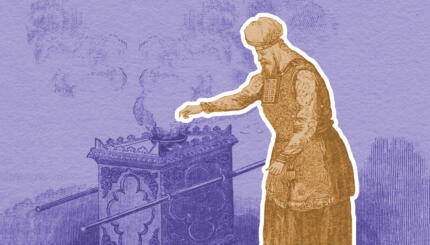The Book of Numbers is composed of narrative, legislation, and archival records. Its narrative begins at the point where Exodus leaves off. (Leviticus, which interrupts the flow of narration, consists almost entirely of legislation independent of historic precedent–with the exception of Lev. 16.) Exodus ends by relating the erection of the Tabernacle on the first day of Nissan, and Numbers starts with a census taken a month later, just a little over a year after the Children of Israel came out of Egypt.
The book covers the years of the people’s wanderings in the desert. However, only the beginning and closing periods of the journey are described in some detail; the thirty‑eight years in which a new generation matures receive no attention at all. Biblical memory accords no further place to those who were saved from Egypt but did not prove worthy of the gift of freedom and so were condemned to die in the desert.
The law given is usually case law, arising from the specific circumstances in the narrative. For instance, telling the story of the dedication of the Tabernacle occasions the statement of priestly obligations and privileges in general. From the law applicable to a particular event told in the book, the Torah proceeds to state the broader law valid for all time.
The Four Main Sections
The book falls into four broad sections. The first (1:1 – 10:10) deals with regulations promulgated at Sinai; it contains demographic and legal material of the most varied kind: from the holding of a census to the ordeal of bitter waters; from prescriptions for offerings to the use of the silver trumpets. It also includes the story of how the Tabernacle was consecrated after it had been set up.

Help us keep Jewish knowledge accessible to millions of people around the world.
Your donation to My Jewish Learning fuels endless journeys of Jewish discovery. With your help, My Jewish Learning can continue to provide nonstop opportunities for learning, connection and growth.
The second part (10:11‑20:1).reports highlights of the early days of the march; emphasizing the various rebellions which occurred, especially the uprising of Korah, Dathan, and Abiram; and then it tells of the end of the old leadership: the deaths of Miriam and Aaron, the judgment on Moses, and the selection of Eleazar and Joshua as the new priestly and secular leaders who will bring the people into Canaan.
The third section (22:2-24:25) is the “Book of Balaam,” which according to some was once a separate book by that name.
The final part (25:1-36:13) begins with events immediately preceding the invasion of Canaan: the elevation of Phinehas, the holding of a new census, and the first land distribution. The boundaries of the Promised Land are set and final instructions before the crossing are given.
Literary Aspects: The End of the Beginning
In effect, the Book of Numbers tells of the end of the journey begun in Egypt or, in the wider sense, begun in the hour of creation. Everything points to this moment when Israel is at last poised to take possession of its inheritance. Based on this and other considerations, it has been suggested that the first four books of the (Genesis, Exodus, Leviticus, Numbers) originally formed a four‑part unit called Tetrateuch by modern scholars, while Deuteronomy, Joshua, Judges, Samuel, and Kings constituted another separate complex …
While reference is made repeatedly to critical analysis as an important aid to the understanding of the Torah, the text is generally treated as a literary unit, not because it always was of one piece (it was not), but because in the final editing process it was so treated and because ever since the readers of the Torah have approached it in this fashion.
Numbers and History: Is It Accurate?
What historical accuracy in the modern sense can we ascribe to Numbers? It is not possible to answer this question precisely because the entire Torah is essentially a document of faith, that is to say, reality is viewed as an aspect of divine and human interaction. Memories and traditions of events (which we might describe as “history“) were intermingled with cultic and symbolic elements.
From this grew a vision of the past as it might have been and as it was later believed to have been in fact. In this way, myth and legend helped both to create and fashion “history.” The need to view the biblical narrative on its own terms rather than ours has been cogently stated by George E. Mendenhall (in The Tenth Generation):
“The biblical narratives rarely if ever give any description of the real‑life context of the event described in words… As a result, every bit of data in an ancient narrative must be viewed against all the evidence we can muster for the purpose of finding the range of ideas and associations which that item of historical fact had in ancient life.
“It is for this reason that the comparative method is not only legitimate, it is essential. After all, every translation of the Bible into modern English is based upon an unconscious presupposition that the range of meaning of an ancient word or act compares often enough with the range of meaning of modern words to make translation possible. The extent to which we deceive ourselves in this unconscious presupposition is not known until we become aware of hitherto unknown contrasts in meaning between the two vocabularies.
“Biblical fundamentalism, whether Jewish or Christian, cannot learn from the past because in so many respects the defense of presently accepted ideas about religion is thought to be the only purpose of biblical narrative. It must, therefore, support ideas of comparatively recent origin‑-ones that usually have nothing to do with the original meaning or intention of biblical narrative because the context is so radically different…”
Falling Short and Forging a Nation
The major locale of the book is the desert, that is, the Sinai Peninsula, and especially its eastern part, the Negev. The environment is harsh, but God deems it necessary for Israel’s spiritual development. The desert is the place where the people’s failures are punished… This is the “desert motif” that underlies the Book of Numbers, which continues from where Exodus left off. Israel is God’s people and is therefore subject to special obligations and laws which are designed to safeguard its holiness.
The book tells us how Israel continued to fall short of its divinely appointed goals; how, because of its murmurings, rebellions, and transgressions of various kinds, God was time and again disappointed in His people. Still, though individuals were punished and a whole generation was condemned to die in the wilderness, the covenant was not abrogated: the sanctuary–with its divine manifestations–remained in the midst of the camp, and God never ceased to guide and protect His chosen ones. The period of wanderings may be seen as a trial of faith, and at the end of the book there emerges the vision of a new nation which will take possession of the Holy Land and do so as a holy people.
The Name of the Book
The name of the book is an English rendering of the Latin Numeri, which in turn was a translation of the Greek Arithmoi, chosen in recognition of the extensive statistical material which opens the book. The name is probably related to an earlier Hebrew appellation for the book, Humash Hapikudim (Mishnah Menachot 4:3). The book was occasionally also referred to by its first Hebrew word, (Sefer) Vayedaber. Its popular Hebrew name is Bemidbar (in the wilderness), so called after bemidbar Sinai, the fifth and sixth words in the opening chapter, a fitting title for a book that relates the major events from Sinai to the Plains of Moab.
Excerpted from The Torah: A Modern Commentary, with the permission of UAHC Press.



